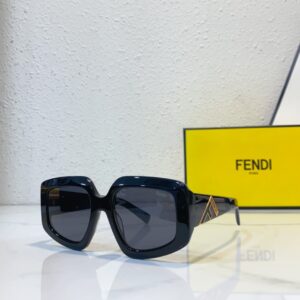Understanding the Importance of Lens Quality
When selecting sunglasses, the quality of the lenses is paramount, particularly when considering replica eyewear. High-quality lenses offer essential protection against harmful ultraviolet (UV) rays, which can cause significant damage to the eyes over time. Poorly manufactured lenses often fail to provide adequate UV protection, exposing the wearer to risks such as cataracts and retinal damage. Therefore, understanding the type and quality of lenses is essential for maintaining eye health.
There are various types of lenses available on the market, with polarized and UV-protection lenses being among the most common features to look for in quality sunglasses. Polarized lenses are designed to reduce glare from reflective surfaces, making them particularly beneficial for individuals who spend time outdoors, engaging in activities such as driving or water sports. These lenses enhance visual comfort and clarity, helping prevent eye strain caused by excessive light.
In addition to polarized lenses, UV-protection lenses are critical in safeguarding against the sun’s harmful rays. Quality lenses should block 99% to 100% of UVA and UVB radiation, ensuring that the eyes are shielded from potential damage. When purchasing replica eyewear, it is vital to verify that the lenses provide sufficient UV protection, as inferior lenses can lead to distorted vision or an inadequate barrier against harmful sunlight.
The risks associated with wearing poorly manufactured lenses extend beyond discomfort. For instance, wearing sunglasses that do not meet quality standards can lead to temporary symptoms, such as headaches and blurred vision, or long-term health concerns due to unregulated UV exposure. Each person should prioritize lens quality when choosing sunglasses to ensure a balance between style and eye safety, particularly in the realm of replica eyewear.
Visual Indicators of Poor Manufacturing
When evaluating the quality of sunglasses, paying attention to visual indicators is essential. The alignment of the frame and lenses is one of the first aspects to examine. Properly manufactured sunglasses should have lenses that are symmetrically positioned within the frame. If you see that one lens sits higher than the other or that the fit appears uneven, this is often a sign of poor craftsmanship, which can impact comfort and effectiveness.
Another critical aspect to inspect is the lens material itself. High-quality sunglasses typically utilize premium materials, which are designed to be free of blemishes. Look for any scratches, bubbles, or distortions within the lenses, as these defects are indicators of subpar manufacturing processes. The presence of bubbles, in particular, suggests that the lenses were not properly molded or treated, while scratches can affect both the clarity and the protective qualities of the eyewear.
Furthermore, it is important to scrutinize the branding and logo placement on the sunglasses. Well-manufactured eyewear will exhibit precise and accurate printing or engraving of the logo. Inconsistencies, such as misaligned logos or poorly executed graphics, can signify replicated or counterfeit products. The font should be clear, and the colors should match the brand’s specifications. Any signs of fading or blurring are additional red flags that the sunglasses may be of low quality.
In addition to the aforementioned elements, inspecting the overall craftsmanship is crucial. Look for signs such as rough edges on the frame, excessive glue, or uneven seams. Each of these factors plays a significant role in determining the durability and reliability of the sunglasses. By carefully assessing these visual cues, one can make a more informed decision regarding the quality of the eyewear in question.
Performance Testing Methods for Lens Quality
Evaluating the quality of sunglasses lenses is crucial to ensuring optimal eye protection and visual clarity. Several practical tests can be performed at home to assess the performance of sunglasses before making a purchase.
One effective method for testing polarization is the pen test. To conduct this test, take a polarized pen or sunglasses and hold them in front of your eyes. Then, place the sunglasses in front of the pen at a 90-degree angle. Rotate the sunglasses and observe if the pen becomes obscured or the darkening effect occurs. If the pen appears more visible in certain angles, it indicates a poorly manufactured lens lacking proper polarization.
Next, testing for UV protection is essential, as inadequate UV blocking can lead to long-term eye damage. While it is best to rely on professional equipment for a precise measurement, a basic method involves using a UV flashlight. Shine the flashlight through the lenses and observe if any UV light is blocked. High-quality sunglasses should prevent UV radiation from passing through, helping to protect the eyes effectively. If the light passes through, this indicates a lack of adequate UV protection.
Additionally, clarity tests can reveal distortion in the lenses, which can affect vision. To perform this test, find a straight line, such as a line on a wall or a text passage on a page. Hold the sunglasses at eye level while focusing on the line. If the line appears to bend or waver, it suggests that the lenses are not of acceptable quality. Quality lenses should allow for unobstructed vision without distortion.
By applying these performance testing methods—pen test for polarization, UV light tests for protection, and clarity tests to identify distortion—consumers can make informed decisions and ensure they are investing in high-quality sunglasses that meet safety standards.
Making Informed Decisions When Buying Replica Eyewear
In the world of fashion and accessories, replica sunglasses often attract shoppers due to their lower price points. However, understanding how to make informed decisions when purchasing these products is crucial to avoid inferior quality items. When considering replica eyewear, thorough research is essential. Begin by examining various brands that offer replicas, and look for those that strive to replicate the quality and aesthetics of the original designs. A brand’s reputation can often provide insight into the product quality.
Customer reviews are another vital aspect of the purchasing process. They can reveal much about the experiences of previous customers and give you a clearer picture of the product’s durability and overall lens quality. Focus on reviews that specifically mention the lenses, as this part of the eyewear is critical to achieving proper UV protection and visual clarity. Look for recurring comments regarding lens performance and build quality, which can significantly aid in discerning reliable products from substandard ones.
Understanding warranty policies can also play a significant role in your purchasing decision. Sellers that offer comprehensive warranty options often stand behind the quality of their products, giving customers peace of mind. Additionally, don’t hesitate to inquire about lens specifications. Inquire about the materials used and whether they provide any UV protection, as some replicas may compromise on essential features that could affect eye health.
Lastly, supporting reputable sellers not only aids in acquiring better-quality items but also promotes ethical practices in the fashion industry. Investing in quality eyewear, even in the replica segment, can ensure you receive functional products while enjoying the aesthetics you desire. By keeping these strategies in mind, you are more likely to make informed decisions in purchasing replica sunglasses that meet your expectations.



